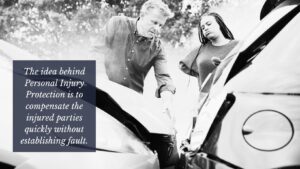Clients often seek clarification about the treatment of car accident claims in New Mexico. When accident victims begin to worry about who is responsible for the damages, one common question is, “Is New Mexico a no-fault state?” The short answer is no. New Mexico is not a no-fault state. In no-fault states, drivers each file claims with their own insurance companies, regardless of who caused the accident.
 Image by pixelshot by Canva.com
Image by pixelshot by Canva.com
The more detailed answer is that New Mexico operates under a fault-based system where the person who caused the accident, or their insurance company, pays claims for all parties involved. Here’s what that means for you if you were the victim of an accident.
Understanding Fault-Based Systems
In New Mexico, as in many other states, the fault-based system is the cornerstone of determining liability in car accidents. This system is sometimes referred to as a tort system. There are many aspects to this system and how they affect parties involved in an accident.
Determining Fault
When there is a claim being made after a car accident, one of the first things that insurance companies and personal injury lawyers try to do is determine who was at fault. This can be a complex process involving law enforcement, insurance companies, and sometimes the courts. Factors such as traffic violations, witness statements, and physical evidence from the accident scene play a crucial role in establishing fault.
Financial Responsibility
Once fault is determined, the party at fault is deemed financially responsible for the damages incurred by the other party. This includes, but is not limited to, medical expenses, property damage, lost wages, and potential pain and suffering. The at-fault party’s insurance typically covers these costs, but it’s worth noting that insurance companies have an interest in not paying out money, so the other drivers’ insurance company is going to try their hardest to deny that the person they insured was the party at fault. Still, the at-fault party may be personally liable if the expenses exceed their insurance coverage.
Comparative Negligence
New Mexico operates under a “pure comparative negligence” rule. This means you can still recover damages if you are partially at fault for the accident. However, your compensation will be reduced by the percentage of your fault. For example, if you are found to be 30% at fault and your damages amount to $10,000, you could recover 70%, or $7,000.
Uninsured and Underinsured Motorist Coverage
What happens if the at-fault driver doesn’t have insurance or doesn’t have enough insurance to cover your damages? In New Mexico, drivers are required to have uninsured and underinsured motorist coverage as part of their auto insurance policy. This coverage can help pay for your damages if an uninsured driver hits you or whose insurance isn’t sufficient to cover your costs.
Legal Representation
In a fault-based system, legal representation can be invaluable. Suppose you are involved in an accident, especially with injuries or significant property damage. In that case, it is wise to consult an attorney. A personal injury lawyer with experience in New Mexico’s fault-based system can help ensure your rights are protected and that you receive the compensation you are entitled to.
No-Fault States: A Comparison
In contrast to New Mexico’s fault-based system, some states in the US operate under a no-fault insurance system. This alternative approach to handling car accidents has different rules, procedures, and implications for drivers.
Basic Principles
In no-fault states, when an accident occurs, each driver’s insurance policy is responsible for paying medical expenses and lost wages, regardless of who was at fault for the accident. This means if you are involved in an accident in a no-fault state, you would typically file a claim with your own insurance company for personal injury protection (PIP) benefits rather than pursuing a claim against the other driver’s insurance.
Personal Injury Protection (PIP)
Personal Injury Protection is a key component of no-fault insurance. PIP covers medical expenses and, in some cases, lost wages and other damages, regardless of who was at fault for the accident. The idea behind PIP is to compensate the injured parties quickly without establishing fault.
 Image by Monkey Business at Canva.com
Image by Monkey Business at Canva.com
Thresholds for Lawsuits
While no-fault insurance is designed to reduce the number of lawsuits, it doesn’t eliminate the possibility. Most no-fault states have thresholds that, if met, allow an injured party to pursue a lawsuit against the at-fault driver. These thresholds are based on the severity of the injuries or the amount of medical expenses incurred.
States with No-Fault Insurance
Twelve states and Puerto Rico have no-fault auto insurance laws: Florida, Hawaii, Kansas, Kentucky, Massachusetts, Michigan, Minnesota, New Jersey, New York, North Dakota, Pennsylvania, and Utah. It’s important to note laws can change, so always check for the most current information.
Pros and Cons
There are both advantages and disadvantages to the no-fault system. On the positive side, no-fault insurance can expedite the claims process, as there’s no need to establish fault before paying benefits. This can be particularly beneficial in cases where fault is difficult to determine.
However, on the downside, no-fault insurance often comes with higher premiums. Some critics argue it allows negligent drivers to avoid full accountability for their actions, as they aren’t directly responsible for the injured party’s medical expenses.
Predictability for Insurance Companies
No-fault systems provide more predictability for insurance companies. Since insurance companies know they will pay out on each claim regardless of fault, they can more accurately predict costs and set premiums accordingly. This can be beneficial for the insurance market’s stability.
Focus on Recovery
By removing the need to establish fault, no-fault systems allow accident victims to focus on their recovery rather than becoming entangled in lengthy legal battles. This can benefit the well-being of individuals who have already suffered the trauma of an accident.
Controlling Fraud and Abuse
Some proponents of no-fault systems argue that they can help control insurance fraud and abuse. By standardizing the claims process and reducing the number of lawsuits, it may be easier to identify and investigate fraudulent claims.
Special Cases: Pedestrians and Delivery Trucks
In car accidents, not all scenarios are as straightforward as a collision between two passenger vehicles. Sometimes, pedestrians or commercial vehicles like delivery trucks are involved, and these cases can have unique complexities. Let’s dissect these special cases within the context of New Mexico’s fault-based system.
Pedestrians
When a pedestrian is involved in a car accident, the stakes are often higher due to the increased likelihood of serious injuries. In New Mexico, the fault-based system still applies, but determining fault can be more nuanced. Fault might be attributed to the driver, the pedestrian, or both—For instance, a driver might be at fault for not yielding to a pedestrian at a crosswalk; conversely, pedestrians might be at fault for jaywalking or darting into traffic. Often, both parties share some degree of fault.
As mentioned earlier, New Mexico follows a pure comparative negligence rule. This means that even if pedestrians are partly at fault, they can still recover damages. Still, the amount will be reduced by their percentage of fault.
In cases where the driver is at fault, the driver’s auto insurance typically covers the pedestrian’s medical expenses and other damages. However, suppose the driver is uninsured or underinsured. In that case, the pedestrian may need to rely on their insurance or pursue legal action.
Delivery Trucks
Accidents involving delivery trucks can be particularly complicated due to the potential involvement of corporate entities. As with any accident, the first step is determining who was at fault. This could be the delivery truck driver, the other driver, or both. However, the truck’s maintenance and the driver’s schedule could also play a role.
In New Mexico, if a delivery truck driver is at fault for an accident while on the job, the company they work for may also be liable. This is known as vicarious liability. The company’s liability insurance may cover damages, which can be particularly important in severe injuries or extensive property damage.
When a corporate entity is involved, legal proceedings can become more complex. Companies often have legal teams and insurance adjusters working to minimize their liability. Injured parties need knowledgeable legal representation to navigate these complexities and advocate for their rights.
Understanding the differences between fault and no-fault systems is crucial if you’re involved in a car accident. In New Mexico, it’s important to establish fault to receive compensation for any injuries or damages. Suppose you have been involved in an accident and need legal assistance. In that case, it’s advisable to consult a personal injury lawyer well-versed in New Mexico’s fault-based system.
